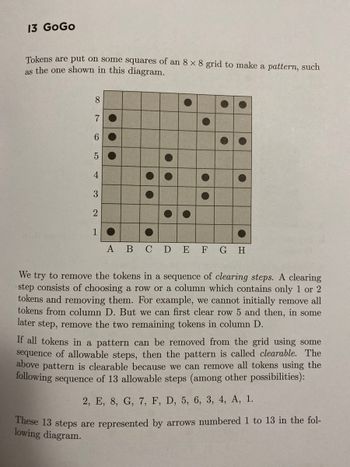a Show that the pattern above can be cleared in 11 steps. b Explain why it is impossible to clear the pattern above in fewer than 11 steps.
a Show that the pattern above can be cleared in 11 steps. b Explain why it is impossible to clear the pattern above in fewer than 11 steps.
Advanced Engineering Mathematics
10th Edition
ISBN:9780470458365
Author:Erwin Kreyszig
Publisher:Erwin Kreyszig
Chapter2: Second-order Linear Odes
Section: Chapter Questions
Problem 1RQ
Related questions
Question

Transcribed Image Text:21-11-16
●
●
L-
8
7
6
5
4
3
I
2
1
--> 13
1
A B C D E
F
G H
a Show that the pattern above can be cleared in 11 steps.
b Explain why it is impossible to clear the pattern above in fewer than
11 steps.
c Explain why the following pattern is not clearable.
8
7
6
5
4
2
1
A B C D E F G H
d What is the smallest number of tokens that can appear in a non-
clearable pattern? Explain your answer.
I
2
I
I
6-
29
-> 3
-> 5
-> 9
----> 8
19
C
--> 11
----> 10
----> 1

Transcribed Image Text:13 GoGo
Tokens are put on some squares of an 8 x 8 grid to make a pattern, such
as the one shown in this diagram.
8
7
6
5
4
3
2
1
A B C D E F G H
We try to remove the tokens in a sequence of clearing steps. A clearing
step consists of choosing a row or a column which contains only 1 or 2
tokens and removing them. For example, we cannot initially remove all
tokens from column D. But we can first clear row 5 and then, in some
later step, remove the two remaining tokens in column D.
If all tokens in a pattern can be removed from the grid using some
sequence of allowable steps, then the pattern is called clearable. The
above pattern is clearable because we can remove all tokens using the
following sequence of 13 allowable steps (among other possibilities):
2, E, 8, G, 7, F, D, 5, 6, 3, 4, A, 1.
These 13 steps are represented by arrows numbered 1 to 13 in the fol-
lowing diagram.
O
.
P
C
A
C
Expert Solution
This question has been solved!
Explore an expertly crafted, step-by-step solution for a thorough understanding of key concepts.
This is a popular solution!
Trending now
This is a popular solution!
Step by step
Solved in 2 steps with 1 images

Follow-up Questions
Read through expert solutions to related follow-up questions below.
Follow-up Question
could you please explain how to do parts c. and d.

Transcribed Image Text:13 GoGo
Tokens are put on some squares of an 8 x 8 grid to make a pattern, such
as the one shown in this diagram.
8
7
6
5
4
3
2
1
A B C D E F G H
We try to remove the tokens in a sequence of clearing steps. A clearing
step consists of choosing a row or a column which contains only 1 or 2
tokens and removing them. For example, we cannot initially remove all
tokens from column D. But we can first clear row 5 and then, in some
later step, remove the two remaining tokens in column D.
If all tokens in a pattern can be removed from the grid using some
sequence of allowable steps, then the pattern is called clearable. The
above pattern is clearable because we can remove all tokens using the
following sequence of 13 allowable steps (among other possibilities):
2, E, 8, G, 7, F, D, 5, 6, 3, 4, A, 1.
These 13 steps are represented by arrows numbered 1 to 13 in the fol-
lowing diagram.
O
.
P
C
A
C
Solution
Recommended textbooks for you

Advanced Engineering Mathematics
Advanced Math
ISBN:
9780470458365
Author:
Erwin Kreyszig
Publisher:
Wiley, John & Sons, Incorporated

Numerical Methods for Engineers
Advanced Math
ISBN:
9780073397924
Author:
Steven C. Chapra Dr., Raymond P. Canale
Publisher:
McGraw-Hill Education

Introductory Mathematics for Engineering Applicat…
Advanced Math
ISBN:
9781118141809
Author:
Nathan Klingbeil
Publisher:
WILEY

Advanced Engineering Mathematics
Advanced Math
ISBN:
9780470458365
Author:
Erwin Kreyszig
Publisher:
Wiley, John & Sons, Incorporated

Numerical Methods for Engineers
Advanced Math
ISBN:
9780073397924
Author:
Steven C. Chapra Dr., Raymond P. Canale
Publisher:
McGraw-Hill Education

Introductory Mathematics for Engineering Applicat…
Advanced Math
ISBN:
9781118141809
Author:
Nathan Klingbeil
Publisher:
WILEY

Mathematics For Machine Technology
Advanced Math
ISBN:
9781337798310
Author:
Peterson, John.
Publisher:
Cengage Learning,

